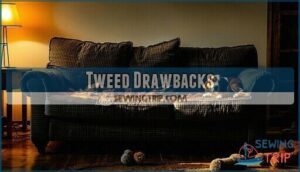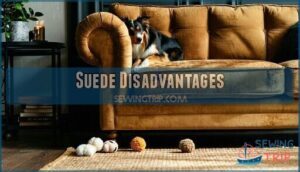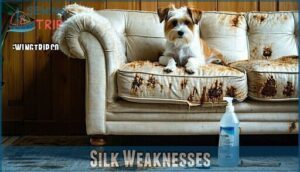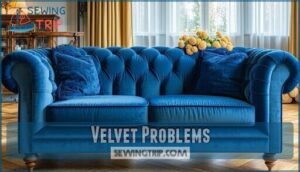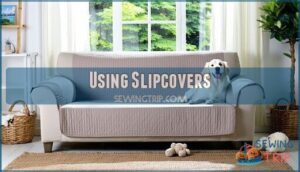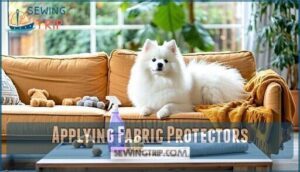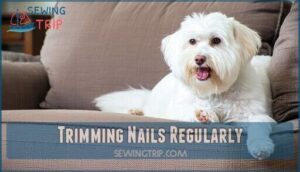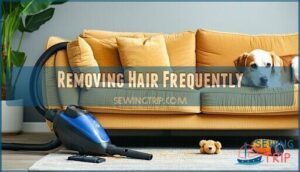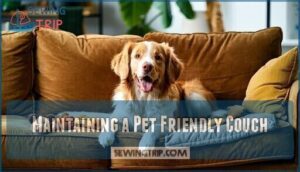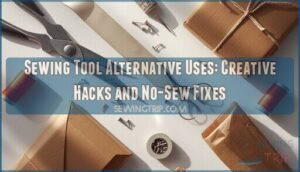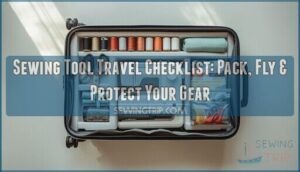This site is supported by our readers. We may earn a commission, at no cost to you, if you purchase through links.

Microfiber tops the list with its superior pet hair resistance and easy cleaning properties.
Leather naturally repels hair and wipes clean from accidents, while performance fabrics like Crypton offer built-in stain and odor protection.
Outdoor acrylics provide maximum durability against claws and chaos.
Avoid fabrics like velvet, suede, and silk that trap hair and stain permanently.
The secret lies in tight weaves and solution-dyed fibers that create an invisible shield against daily pet challenges.
Table Of Contents
Key Takeaways
- Choose microfiber or leather for maximum durability – You’ll get pet hair resistance, easy cleanup with just damp cloths, and materials that won’t trap odors or stains permanently.
- Avoid velvet, suede, and silk at all costs – These fabrics trap pet hair deeply, absorb stains permanently, and tear easily from claws, creating expensive maintenance nightmares.
- Look for tight weaves and solution-dyed fibers – You’ll want materials with Martindale ratings above 20,000 and embedded stain protection that won’t wash away over time.
- Protect your investment with regular maintenance – You’ll extend your couch’s life by trimming your dog’s nails weekly, using fabric protectors every 6-12 months, and removing pet hair frequently.
Choosing Dog Friendly Fabrics
When you’re shopping for a dog friendly couch, fabric durability becomes your best friend.
Your furry friend’s comfort shouldn’t compromise your couch’s survival.
Smart fabric choices save you from constant cleaning battles
Your furry companion won’t hesitate to jump, scratch, and shed all over your furniture, so choosing the right materials makes all the difference.
Microfiber benefits include superior pet hair resistance and stain-free materials that handle accidents with ease.
This tightly woven synthetic fabric creates a dog proof couch surface that resists tears while offering simple cleanup with just a damp cloth.
Leather options provide exceptional durability and naturally repel pet hair, making maintenance effortless.
Though pricier, leather develops character over time rather than showing damage.
Performance fabrics like Crypton and outdoor acrylics deliver stain resistant couch solutions with built-in protection against odors and moisture.
These durable upholstery choices combine synthetic fibers for maximum resilience against daily pet challenges while maintaining comfort and style.
Fabrics to Avoid With Dogs
While some fabrics seem pet-friendly at first glance, certain materials can become your worst nightmare when living with dogs.
You’ll want to steer clear of tweed, suede, silk, and velvet if you’re serious about maintaining a clean, damage-free couch, especially considering suede can be particularly problematic.
Tweed Drawbacks
Choosing tweed upholstery invites a world of pet-related headaches.
This fabric’s loose weave acts like a magnet for pet hair, making removal nearly impossible even with powerful vacuums.
Fabric snags occur easily when claws catch the textured surface, creating unsightly pulls and tears.
Dirt accumulation becomes a constant battle as debris settles deep into the weave, while pet damage accelerates due to tweed’s vulnerability to scratching and snagging.
For a more practical solution, consider opting for pet friendly materials that can withstand the wear and tear of pets, providing a more pet-friendly and practical approach.
Suede Disadvantages
Suede poses serious problems for dog owners.
This high maintenance fabric absorbs moisture instantly, creating permanent water spots from pet accidents.
Its delicate nap traps pet hair deeply, making removal nearly impossible without professional help.
Key suede problems include:
- Stain vulnerability – Pet urine and oils penetrate quickly, causing lasting odors
- Difficult cleaning – Requires specialized care that often fails completely
- Pet hair issues – Fur embeds in the nap, resisting vacuuming
You’ll face constant battles with dog scratches on couches and pet hair on furniture when choosing suede over stainresistant couch fabrics and odorresistant fabrics.
Consider opting for pet friendly fabrics to minimize these issues.
Silk Weaknesses
Silk ranks among the worst fabrics for dog owners due to its fragile nature and high maintenance requirements.
Silk tears at the first scratch and absorbs every stain permanently
This luxury material simply can’t handle the realities of pet ownership.
Here’s why silk fails as a dog-friendly fabric:
- Fabric tears easily – Dog claws slice through delicate silk fibers like butter
- Silk stains permanently – Pet accidents create lasting marks that won’t come out
- Delicate care required – Professional cleaning costs add up quickly with frequent mishaps
- Poor silk durability – Regular use accelerates wear and breakdown
- Pet hair attracts strongly – Static cling makes dog hair removal nearly impossible
Unlike stain-resistant fabrics or odor-resistant fabric options, silk absorbs everything and holds onto it.
The delicate fibers can’t compete with dog hair-resistant materials that actually repel pet mess instead of absorbing it.
Velvet Problems
Despite velvet’s luxurious appeal, it creates a perfect storm for pet owners.
Velvet’s plush fibers act like magnets for pet hair, making removal nearly impossible. The fabric’s absorbent nature means odor retention becomes a serious problem.
Even minor scratches create visible fabric snags that ruin the surface permanently.
| Issue | Impact | Solution |
|---|---|---|
| Pet Hair Trapping | Hair embeds deep in fibers | Daily lint rolling required |
| Stain Issues | Liquids absorb immediately | Professional cleaning only |
| Odor Retention | Smells linger indefinitely | Steam cleaning needed |
| Fabric Snags | Claws create permanent damage | No effective repair |
Key Features for Dog Owners
When selecting couch fabric with dogs, you’ll need materials that withstand daily wear from claws, accidents, and constant use.
The right fabric choices make the difference between furniture that lasts years versus months in a pet-friendly home.
Durability Importance
When faced with energetic paws and playful claws, fabric strength becomes your couch’s armor against daily wear.
Durable couch materials with superior wear resistance prevent costly replacements while maintaining comfort. Look for dogproof upholstery that combines material longevity with tear prevention—these petfriendly fabrics withstand scratching, jumping, and general roughhousing.
Quality pet proofing means choosing stainresistant couch fabrics that laugh off accidents and dog hair resistant surfaces that simplify cleanup routines.
For ideal protection, consider durable fabric options that provide long-lasting performance.
Weave and Stain Resistance
Beyond surface protection, tight weave fabrics create your first defense against pet chaos.
Microfiber benefits shine through ultra-dense construction that blocks stains before they penetrate. Synthetic materials outperform natural fibers consistently.
Key stain resistance features you need:
- Solution-dyed fibers – Color won’t fade when accidents happen
- Martindale ratings above 20,000 – Proven durability against claws
- Embedded protection – Chemical barriers that don’t wash away
- Non-porous structure – Liquids bead up instead of soaking in
Tight weave fabrics with stain-resistant couch technology give you peace of mind when your dog decides the sofa looks comfortable. When choosing fabrics, consider stain resistant treatments for maximum protection.
Easy Cleaning Options
Three cleaning methods make pet-friendly couches manageable.
Microfiber cleaning requires only damp cloths for stain removal, while leather care needs quick wipes for accidents.
Stain-resistant fabrics with fabric protectors simplify pet stain removal.
Water-resistant fabric options prevent deep soaking.
Easy clean fabric choices like canvas offer machine-washable slipcovers, giving you control over maintenance without professional cleaning services, making them ideal for easy clean maintenance.
Odor Resistance
Microfiber and performance fabrics excel at odor control through their tight weave construction.
These odor resistant fabrics prevent pet scents from penetrating deep into cushions.
Look for materials with built-in fabric treatments that actively repel moisture and bacteria. Low-pile synthetic blends offer superior scent prevention compared to natural fibers that trap odors permanently, providing odor control and superior scent prevention.
Protecting Your Couch From Dogs
Even the best dog-friendly fabric needs protection from daily wear and pet damage.
You can extend your couch’s life substantially with simple preventive measures that keep both you and your furry friend comfortable.
Using Slipcovers
Slipcovers offer budget-friendly couch protection that’s both practical and smart.
These removable covers shield your furniture from pet hair management challenges while providing easy maintenance solutions.
Choose stain-resistant fabrics like microfiber or canvas for superior dogproof upholstery.
Machine-washable slipcover materials transform any couch into pet-friendly fabrics territory.
Quality fabric selection guarantees your investment stays protected without breaking the bank, ensuring a smart investment.
Applying Fabric Protectors
Fabric protectors create an invisible shield that repels liquids and prevents stains from setting into your couch. These protective treatments buy you precious time to clean accidents before permanent damage occurs.
Here’s your application game plan:
- Vacuum thoroughly – Clean surfaces guarantee maximum protector adhesion and effectiveness
- Apply two light coats – Better coverage than one heavy application without oversaturation
- Maintain 6-inch distance – Ideal spray pattern prevents uneven coating or wetness
- Allow full drying – Several hours between coats prevents streaking or residue buildup
- Reapply every 6-12 months – High-traffic pet areas need regular maintenance for continued protection
Fabric sprays like Scotchgard create waterproof coatings that make stain-resistant fabrics even tougher. These fabric sealers provide pet odor protection while maintaining your couch’s original texture and appearance.
Trimming Nails Regularly
Regular nail trimming prevents your dog’s claws from snagging pet friendly fabrics and creating tears in scratch resistant fabric.
Keep nails short to protect dogfriendly fabrics from damage. Weekly claw maintenance reduces furniture wear substantially.
Proper nail care and grooming tips help preserve stainresistant fabrics. This simple pet hygiene practice extends your couch’s lifespan while maintaining its appearance.
For upholstery repairs, using best electric scissors can be very helpful in cutting fabric efficiently, which is a key part of proper nail care and grooming tips to maintain stainresistant fabrics and ensure weekly claw maintenance.
Removing Hair Frequently
You’ll win the battle against pet hair on furniture with consistent removal techniques.
Weekly cleaning prevents buildup and reduces allergens in your home, keeping both you and your pets comfortable.
- Vacuum Cleaners with upholstery attachments target embedded hair in cushion crevices
- Lint Rollers handle daily surface cleaning on dogfriendly fabrics effectively
- Hair Removal Tools like rubber gloves create static electricity to collect stubborn fur
- Pet Grooming reduces overall shedding, making petfriendly furniture maintenance easier
Maintaining a Pet Friendly Couch
Once you’ve chosen the right dog-friendly fabric, proper maintenance keeps your couch looking and smelling fresh for years. Regular care routines prevent permanent damage and extend your furniture’s lifespan substantially.
Regular Grooming
Keeping your dog well-groomed substantially reduces the impact on your dogfriendly couch materials.
Regular nail trimming prevents fabric tears and scratches. Weekly brushing controls shedding and minimizes pet hair fabric accumulation.
Professional dog grooming every 6-8 weeks maintains prime pet hygiene. Consistent claw care protects petfriendly fabric choices from damage.
Proper fur minimization through routine brushing keeps odorresistant fabrics cleaner longer, which is essential for maintaining a clean and healthy environment, and this can be achieved by regular brushing.
Spot Cleaning Techniques
Quick action beats procrastination when accidents happen on your pet-friendly couch.
These spot cleaning essentials keep your furniture fresh:
- Blot immediately with clean cloths to absorb liquid before it penetrates fabric fibers
- Apply mild soap mixed with warm water using gentle circular motions for stain removal
- Remove pet hair with lint rollers or vacuum attachments before cleaning wet spots
- Use fabric protectors designed for stainresistant and odorresistant surfaces after cleaning
- Test cleaning products on hidden areas first to prevent fabric damage or discoloration
Work from outside edges toward the center to prevent spreading stains across your couch’s surface.
Preventing Accidents
Proactive pet training forms the backbone of accident prevention on your furniture.
Establish clear boundaries early, teaching dogs designated couch areas while redirecting destructive behaviors.
Claw control through regular trimming prevents fabric tears, while spill prevention starts with water-resistant fabric choices.
Smart damage minimization combines stain-resistant couch fabrics with odor-resistant materials, creating foolproof barriers against mishaps.
Choosing the right fabric is vital, considering factors like best couch materials to guarantee durability and pet-friendliness.
Choosing Low Maintenance Fabrics
Opt for microfiber and leather when you want hassle-free maintenance.
These durable materials resist stains naturally and clean up with simple wiping.
Microfiber benefits include machine-washable covers and exceptional odor control.
Stain-resistant couch fabrics like performance blends eliminate deep-cleaning headaches.
Pet-friendly fabrics with tight weaves prevent hair embedding, making your life easier with hassle-free maintenance.
Frequently Asked Questions (FAQs)
What is the best couch material for dogs?
Like armor protecting a knight, leather stands as your couch’s best defense against canine chaos.
You’ll want genuine leather or microfiber with tight weaves—they resist tears, repel hair, and wipe clean easily, giving you peace of mind.
They are ideal because they resist tears, and have other beneficial properties.
What are the best couches for dogs?
You’ll find the best couches feature leather, microfiber, or outdoor fabrics. These materials resist scratches, repel hair, and clean easily with simple wipes, keeping your furniture looking fresh.
What is the best furniture material for a dog?
Leather tops the list for dog-friendly furniture materials.
Its durability resists punctures and tears while repelling hair and allowing easy cleanup with simple wipes.
Microfiber offers similar benefits at lower cost.
What fabric is tear resistant to dogs?
Canvas and denim’s tight weaves resist tears from dog claws effectively.
Microfiber’s synthetic construction prevents ripping, while leather scratches actually improve its appearance.
Outdoor acrylic fabrics withstand damage brilliantly, making them excellent choices.
What type of couch filling is best for pets?
High-density foam with memory foam toppers provides superior pet support while resisting permanent impressions.
You’ll want CertiPUR-US certified foam that’s free from harmful chemicals, ensuring your furry friend’s safety and comfort.
Is microfiber couch better than leather for pets?
A stitch in time saves nine" rings true here.
Both microfiber and leather excel for pet owners, but leather wins slightly.
It’s more durable, resists scratches better, and cleans easier with simple wipes, making maintenance effortless.
What is the most durable sofa fabric for dogs?
Top-grain leather delivers unmatched durability for dog owners.
It’s puncture-resistant, repels hair, and scratches actually enhance its character.
For budget-conscious families, tightly woven microfiber offers impressive tear resistance and easy cleanup, providing a practical alternative with unmatched durability being a key consideration.
What fabric is resistant to dog claws?
Leather, microfiber, and tightly woven synthetic fabrics resist claw damage best.
You’ll find leather scratches blend naturally, while microfiber‘s tight weave prevents snags.
Avoid loose weaves like tweed that catch nails.
What type of sofa is best if you have dogs?
While durability matters most, leather sofas reign supreme for dog owners.
They resist scratches, repel fur, and clean easily with simple wipes.
Microfiber with tight weaves offers budget-friendly protection against accidents and odors.
What material is dog proof?
No fabric is truly "dog proof," but leather offers your best defense.
It resists punctures, repels fur, and cleans easily with quick wipes.
Tight-weave microfiber and performance fabrics like Crypton also withstand most pet damage effectively.
Conclusion
Surprisingly, many pet owners discover the best fabric for couches with dogs only after replacing furniture multiple times.
You’ll save money and frustration by choosing microfiber, leather, or performance fabrics from the start.
These materials resist pet hair, repel stains, and clean easily with simple maintenance.
Your couch can look great while surviving daily life with dogs.
Focus on tight weaves and solution-dyed fibers for maximum protection against accidents and scratches, which will help you maintain a beautiful couch with minimal maintenance.
- https://www.zhuoyifabric.com/news/is-suede-fabric-good-for-sofa-72133402.html
- https://www.apartmenttherapy.com/best-sofa-fabrics-for-pet-owners-256230
- https://www.shorescleaners.com/leather-suede/
- https://www.foliofabrics.com/blogs/inspo/pet-friendly-fabrics
- https://atunushome.com/how-to-choose-a-pet-friendly-sectional-sofa-for-your-home/

